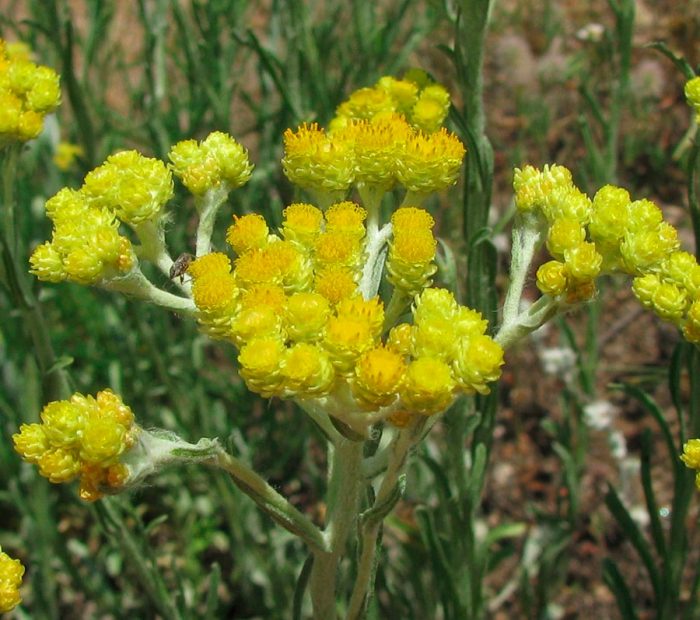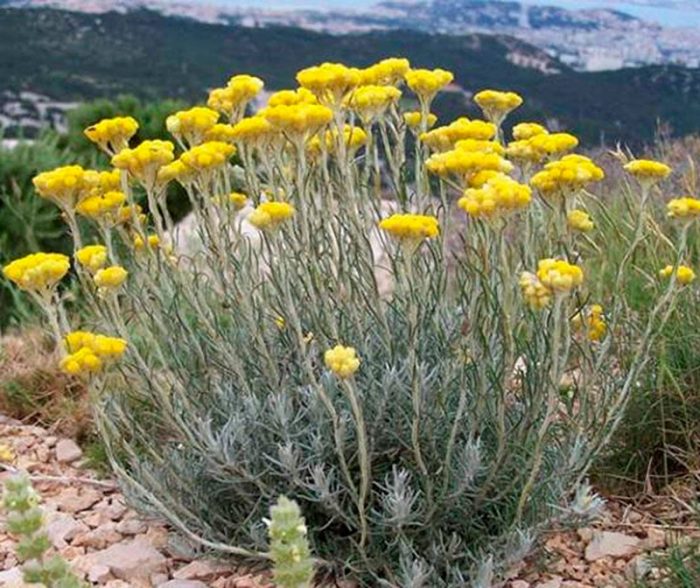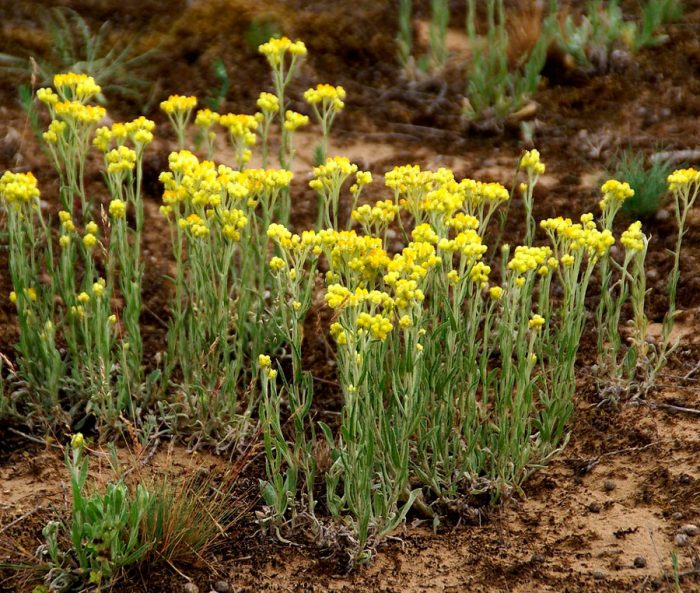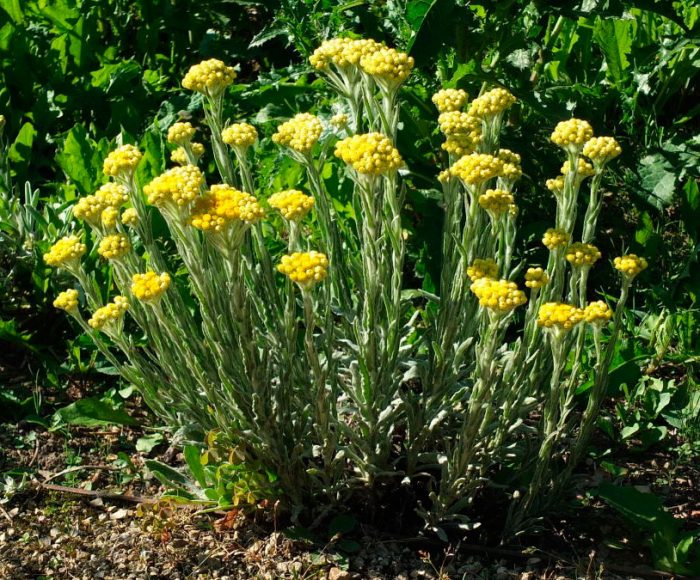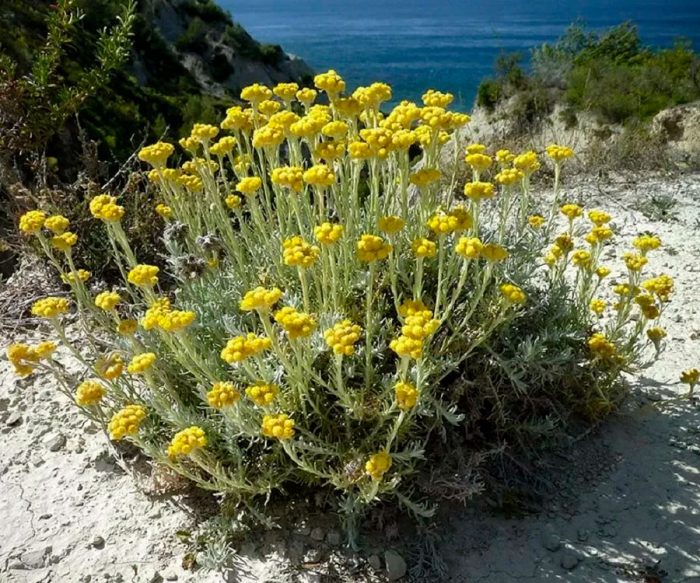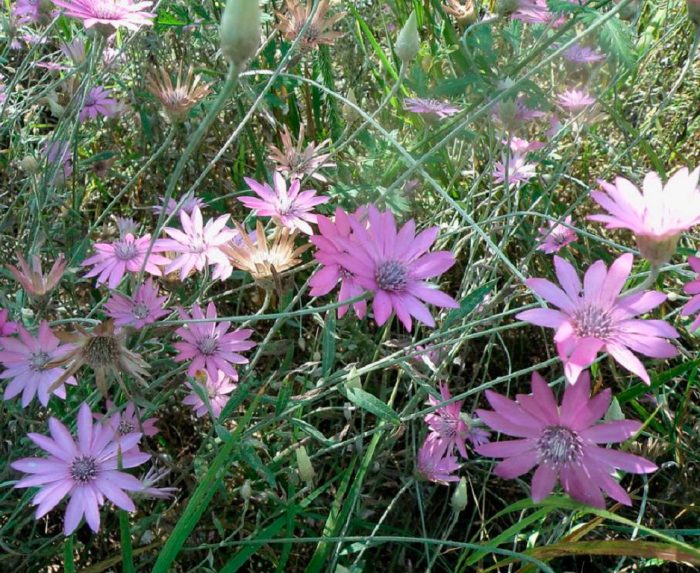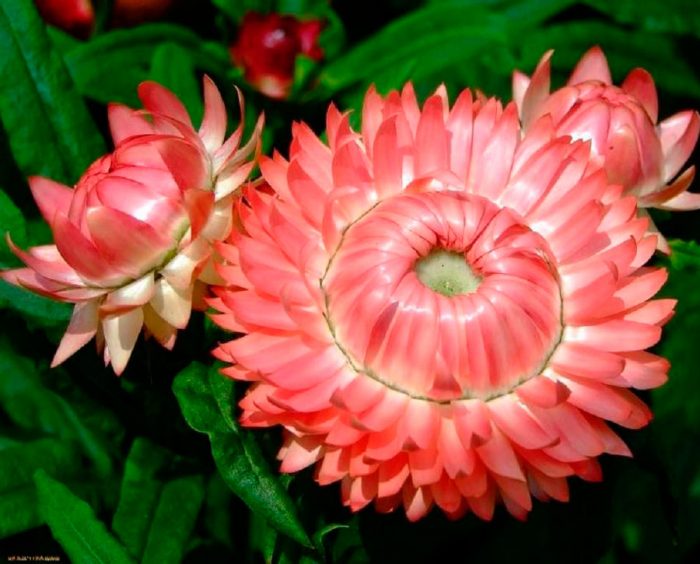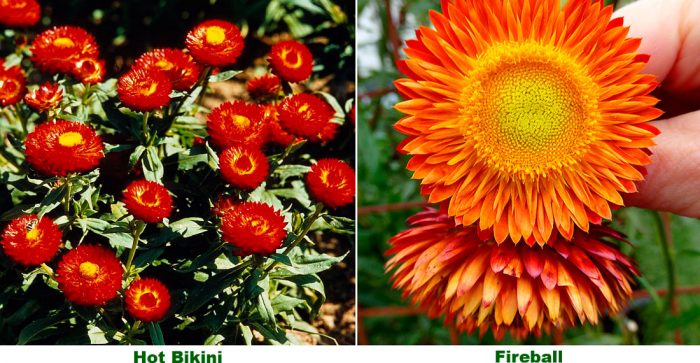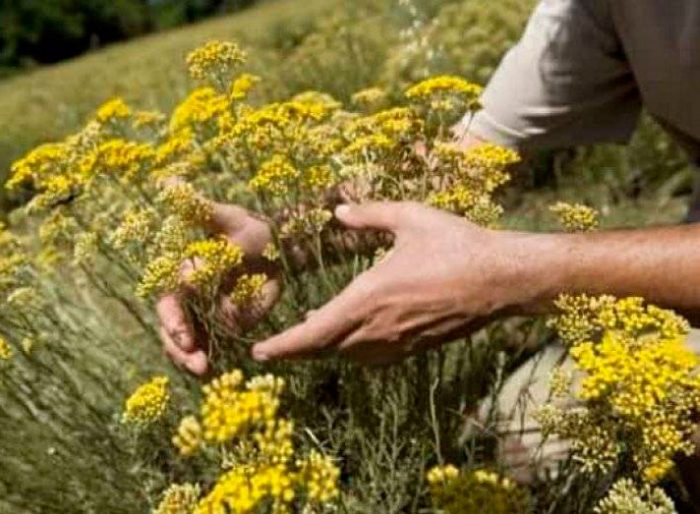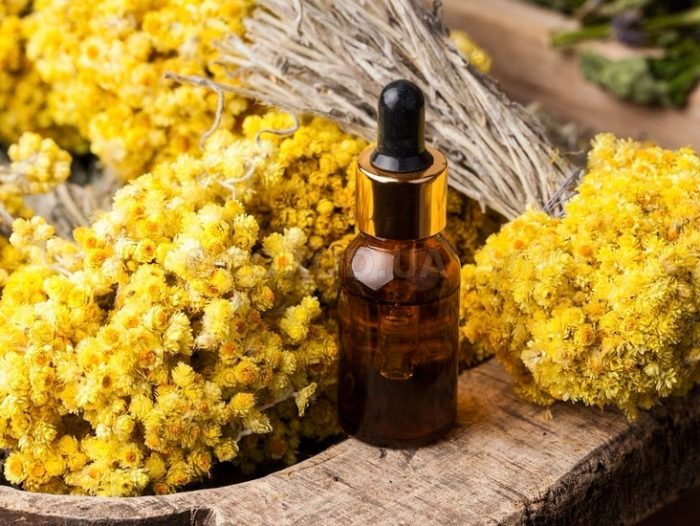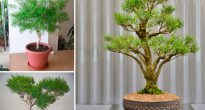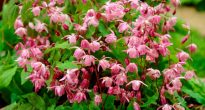A perennial herb the immortelle is part of the Astrov family. It is also popularly called gelikhrizum, zheltyanka and tsmin. Spectacular inflorescences adorn the branching stems. The flowers are small, hard and quite pretty. Moreover, they are able not to lose their beauty for a long time, even if they are dried. The immortelle comes from Asia Minor, Australia and Africa, where it can be found in the Cape region and on the island of Madagascar.
This plant is quite widespread both in landscape design and floristry, and in medicine. The genus unites many species, so if you wish, you can make a spectacular composition. But in order for the bushes to be lush and beautiful, you need to know how to care for them and which site is most suitable for them.
Content
Features of the immortelle
The immortelle is a perennial plant, but there are also annuals. The genus is represented by shrubs and semi-shrubs. Its stems branch strongly and form a beautiful openwork crown. The rhizome is short and very poorly developed. The bush itself can reach a height of 0.3 to 1.2 m. Along the entire length of erect shoots, alternate narrow leaves grow. In some species, the leaf plates growing at the base are larger and opposite. Lanceolate foliage is usually dark green in color. Plaque or short pile on its surface prevents excessive evaporation of moisture.
Flowers adorn the bush from July to September. During flowering, inflorescences are formed in the upper parts of the shoots, which are baskets, reaching 0.4–7 centimeters across (depending on the species). The inflorescences are made up of very small, bisexual, tubular flowers that look like strings. They are surrounded by petals (wrapper) of a rich color. When the bush is just beginning to bloom, its inflorescences are highly dense and almost capitate. After a while, they become less dense. The petals can be painted in pink, purple, bronze, yellow and red, as well as in their various shades. Usually very small baskets are part of the umbellate inflorescence.
The immortelle needs insects for pollination.When the flowers wither, oval-shaped seed pods (similar to prisms) with a woolly surface will form in their place. They have a single-row tuft in the upper part.
Reproduction methods
For the reproduction of the immortelle, both seed and vegetative methods are used. Most of the ornamental varieties are grown as annuals. In this regard, they have to be grown from seeds every year. Only seeds purchased at the store are suitable for sowing. If you want to sow seed material collected by yourself, then you should take into account that the bushes grown from it may not preserve the varietal properties of the parent plant. Annual varieties are also good because they are the most unpretentious.
Growing from seeds
They grow immortelle through seedlings. Prepare the seedling box, which is filled with a moistened substrate of peat and sand. The seed material does not need preparation, it is simply evenly distributed over the surface of the soil mixture and is not sprinkled on top with anything, just press it a little into the substrate.
After 4–6 days, you should already see friendly shoots. When 15–20 days have passed, arrange the seedlings into individual small pots. A transplant into open ground is carried out in the last days of May, but only when the return spring frosts are left behind. When planting between the bushes, you need to leave a distance of 20 to 25 centimeters. During a dive, try not to injure the delicate roots. That is why it is recommended to open the seedlings in peat pots. But you can just carefully plant the grown seedlings, taking it along with an earthen clod.
Sowing seeds can be carried out directly in open ground and do it in the last days of April. But such bushes will bloom much later. And a lush flowering from them can only be expected in the second year of growth. The grown seedlings, if necessary, must be thinned out. While the bushes are young, special attention should be paid to the removal of weeds from the garden and timely watering.
Dividing the bush
If the immortelle is grown as a perennial, then the grown-up bushes must be systematically replanted, while dividing them into parts. In springtime, remove the bush from the soil and divide it into several pieces using a sharp shovel. At the same time, remember that all divisions should have 2 or 3 kidneys.
Propagation by cuttings
Cuttings are harvested in the summer, and young shoots are suitable for this. They give roots quite quickly when planted in containers filled with a soil mixture of sand and garden soil. In the warm season, the cuttings are kept in the garden, and when the cold comes, they are transferred to a warm room. Rooted cuttings are planted in the garden with the onset of the next spring period.
Immortelle care
Seat selection
The immortelle is distinguished by its unpretentiousness, which allows you to grow it on your site without any problems. The first step is to choose the most suitable site for it. Remember that only certain species are recommended to be grown in shade, while others need a lot of light. The soil needs nutritious and loose, and water should not stagnate in it. It is best if it is slightly acidic or neutral.
Dig up the soil in the selected area. If necessary, add compost and complex mineral fertilizer for flowering plants to the soil. Prepare the holes, while at their bottom, be sure to lay a layer of drainage.
Watering
This plant is drought tolerant, but if you water it regularly, it will bloom very luxuriantly. It is recommended to water the bushes with well-settled water warmed up in the sun. The earth should be moistened in the morning or evening, but if the bushes are watered during the day, this can cause burns.
Fertilizer
As a rule, only perennials need systematic fertilization of the soil.To do this, during the growing season, a complex mineral fertilizer or mullein is introduced into the soil 2 or 3 times.
Do not forget to remove weeds from the site in time, and also remove dried foliage, stems and inflorescences that have begun to fade from the bushes.
Diseases and pests
The immortelle is quite resistant to all diseases. Of the pests, nematodes most often settle on it. The pest is located inside the leaf plates and shoots, so simple treatments with insecticidal preparations are ineffective. Experienced gardeners advise how to cut and burn the affected areas of the plant.
Immortelle in landscape design
Airy foliage and spectacular immortelle inflorescences attract the attention of many gardeners. Such a plant is planted near the fence or buildings, and it is also grown in mixed flower beds, rock gardens or rockeries. This culture is very popular with florists. It is often used when drawing garlands, wreaths, and even winter bouquets.
In the autumn, cut off the buds that have begun to open from the bush along with the shoot. Remove all foliage from the branch. Hang it upside down and wait until it is completely dry. The fact that there will be dead dry flowers in your house does not pose any danger, no matter what rumors go around about it, because these are only prejudices.
The immortelle is the keeper of attractiveness and youth. It also relieves ailments, protects sleep, makes the owner more courageous and courageous, and also helps to live every day with joy.
Types of immortelle with photo
In the numerous genus of the immortelle, there are more than five hundred different species. Moreover, only about 30 species are grown in the gardens.
Sandy immortelle (Helichrysum arenarium)
This perennial is found in Eurasia, and it prefers to grow on rocky embankments, salt marshes and sandy loam. A short woody rhizome grows several straight, practically unbranched stems with a height of about 0.3–0.4 m. On the surface of alternate oblong leaf plates, there is a tomentose pubescence. Flowering is observed from June to August, while the plant is decorated with small yellow baskets, reaching from 0.4 to 0.6 centimeters across. Inflorescences are part of larger complex scutes. This flower is used as a medicinal plant in medicine.
Immortelle pink, or meadow
The surface of the branched perennial stems is covered with felt pile. The foliage at the base of the shoots is large and clawed, while on the rest of the stem it is smaller and lanceolate. The baskets include pink female flowers and white male flowers. The bush blooms from May to June.
Big immortelle
The stems of this perennial are well branched and reach a height of 0.6 to 0.8 m. The upright ribbed shoots are decorated with smooth dark green lanceolate foliage. This species differs from the rest in the largest inflorescences of the most saturated color. It is because of this that this species is very popular with gardeners. In the middle of the inflorescence are small tubular flowers, surrounded by glossy, rich color wrappers that can be yellow, red, pink, orange and white. The flowering of this plant begins in July, and it fades with frost. If the flowers are pollinated, then over time, crested seed pods will form in their place.
The best varieties:
- Violet... The height of the bush is about 110 cm, since June it is decorated with lush inflorescences-baskets, reaching from 40 to 60 mm in diameter. The petals can be dark red or purple.
- Fireball... The height of this compact shrub is about 1.15, its foliage is linear. The diameter of the convex inflorescences-baskets is from 50 to 60 mm, while the wrapper is brownish-red.
- Hot Bikini... The height of the branched stems is about 0.3 m. The width of the scarlet inflorescences is about 20 mm.
Immortelle harvesting
Composition
Meadow and sandy immortelle are considered medicinal plants. The inflorescences contain many glycosides, vitamin C, resins, coumarins, trace elements, flavonoids, essential oils, bitterness and dyes.
Collection features
Raw materials are collected when the bush is just blooming, while only those stems are cut off on which the inflorescences have not fully opened. When pruning, the inflorescences are captured up to 1 cm of the peduncle. It is necessary to decompose the collected inflorescences for drying no later than 4 hours after pruning. To do this, they are laid out in one layer on the surface of the rack, located in a well-ventilated and shaded place. Raw materials can be dried in dryers at a temperature not exceeding 40 degrees. Dried inflorescences have a subtle spicy-bitter smell. For storage, they are folded in paper bags or bags sewn from fabric. The shelf life is 3 years.
Healing properties
The inflorescences of this plant are used for the preparation of infusions, broths and tinctures. It can be used alone or included in various herbal preparations. For aromatherapy sessions, immortelle essential oil is used.
Such a shrub has the following beneficial properties: diaphoretic, expectorant, antimicrobial, choleretic, tonic, antispasmodic and hemostatic. It is used in the treatment of a wide variety of ailments, but it helps best of all in the treatment of kidney inflammation, hypotension, atherosclerosis, diabetes mellitus, cholecystitis, gastritis and gout.
Helichrysum decoction will help clear the gallbladder and kidneys from sand and stones. Thanks to him, it is possible to normalize the activity of the circulatory and nervous system, as well as the digestive tract.
Contraindications
It is necessary to take drugs based on immortelle as directed by the attending doctor and under his control. Moreover, they should be part of the complex therapy.
This plant is contraindicated for thrombophlebitis, increased acidity of the stomach, hypertension and obstructive jaundice.

